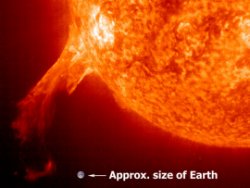 NASA Scientists studying the relationship between the Sun’s magnetic activity and the peak number of sunspots, have discovered a six-year relationship between the two phenomena. If the trend continues as it has since 1868, we should experience a count of about 160 sunspots during the next solar cycle peak, due in 2011. Previous correlations between climate and sunspot count may also indicate a warmer climate during this cycle.
NASA Scientists studying the relationship between the Sun’s magnetic activity and the peak number of sunspots, have discovered a six-year relationship between the two phenomena. If the trend continues as it has since 1868, we should experience a count of about 160 sunspots during the next solar cycle peak, due in 2011. Previous correlations between climate and sunspot count may also indicate a warmer climate during this cycle.
Right: An erupting solar prominence photographed by the Solar and Heliospheric Observatory (SOHO).
NASA – Scientists Predict Big Solar Cycle
Dec. 21, 2006: Evidence is mounting: the next solar cycle is going to be a big one.
Solar cycle 24, due to peak in 2010 or 2011 “looks like its going to be one of the most intense cycles since record-keeping began almost 400 years ago,” says solar physicist David Hathaway of the Marshall Space Flight Center. He and colleague Robert Wilson presented this conclusion last week at the American Geophysical Union meeting in San Francisco.
Their forecast is based on historical records of geomagnetic storms.
Hathaway explains: “When a gust of solar wind hits Earth’s magnetic field, the impact causes the magnetic field to shake. If it shakes hard enough, we call it a geomagnetic storm.” In the extreme, these storms cause power outages and make compass needles swing in the wrong direction. Auroras are a beautiful side-effect.
Hathaway and Wilson looked at records of geomagnetic activity stretching back almost 150 years and noticed something useful:. “The amount of geomagnetic activity now tells us what the solar cycle is going to be like 6 to 8 years in the future,” says Hathaway. A picture is worth a thousand words:
Above: Peaks in geomagnetic activity (red) foretell solar maxima (black) more than six years in advance.
In the plot, above, black curves are solar cycles; the amplitude is the sunspot number. Red curves are geomagnetic indices, specifically the Inter-hour Variability Index or IHV. “These indices are derived from magnetometer data recorded at two points on opposite sides of Earth: one in England and another in Australia. IHV data have been taken every day since 1868,” says Hathaway.
Cross correlating sunspot number vs. IHV, they found that the IHV predicts the amplitude of the solar cycle 6-plus years in advance with a 94% correlation coefficient.
“We don’t know why this works,” says Hathaway. The underlying physics is a mystery. “But it does work.”
According to their analysis, the next Solar Maximum should peak around 2010 with a sunspot number of 160 plus or minus 25. This would make it one of the strongest solar cycles of the past fifty years—which is to say, one of the strongest in recorded history.
Left: Hathaway and Wilson’s prediction for the amplitude of Solar Cycle 24.
Astronomers have been counting sunspots since the days of Galileo, watching solar activity rise and fall every 11 years. Curiously, four of the five biggest cycles on record have come in the past 50 years. “Cycle 24 should fit right into that pattern,” says Hathaway.
These results are just the latest signs pointing to a big Cycle 24. Most compelling of all, believes Hathaway, is the work of Mausumi Dikpati and colleagues at the National Center for Atmospheric Research (NCAR) in Boulder, Colorado. “They have combined observations of the sun’s ‘Great Conveyor Belt’ with a sophisticated computer model of the sun’s inner dynamo to produce a physics-based prediction of the next solar cycle.” In short, it’s going to be intense. Details may be found in the Science@NASA story Solar Storm Warning.
“It all hangs together,” says Hathaway. Stay tuned for solar activity.

